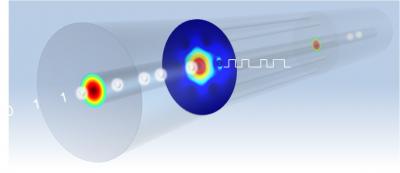A team of physicists, engineers and chemists has developed a new approach where crystalline materials facilitate optical fibers to have integrated, high-speed electronic functions.
 Materials for First Optical Fibers with High-Speed Electronic Function are Developed
Materials for First Optical Fibers with High-Speed Electronic Function are Developed
The optical fibers offer a number of possible applications such as more-accurate remote-sensing devices, improved telecommunications, improved laser technology, and other hybrid optical and electronic technologies.
A postdoctoral researcher in the Department of Chemistry at Penn State University Rongrui He initiated the research. The international team, directed by John Badding, a professor of chemistry at Penn State, will publish its findings in the Nature Photonics journal.
According to Badding, efficient and rapid exchange of information between optics and electronics has become an important challenge. With the existing technology, there is irregular merging of optical fibers with electronic chips. The silicon-based integrated circuits function as the building blocks for computers, cell phones, solar cells, and light-emitting diodes (LEDs). The optical fiber is a passive medium for light transmission, while the chip executes the equation’s electrical part. An optical-electrical-optical (OEO) conversion is the process where electricity and light operate together in synchronization. The integration of chips and optical fibers is complex as the chips and fibers are of varied sizes. The alignment of pieces that are tiny also becomes complicated.
A new approach has been devised where a new kind of optical fiber can be built with its own integrated electronic component, rather than merging a flat chip with a round optical fiber. Hence, the need to integrate fiber-optics onto a chip can be eliminated.
High-pressure chemistry techniques have been implemented in order to deposit semiconducting materials layer by layer, directly into small holes in optical fibers.
Integrating the technology into the fibers promotes the embedded semiconductors to offer further improvements in the optoelectronic applications.